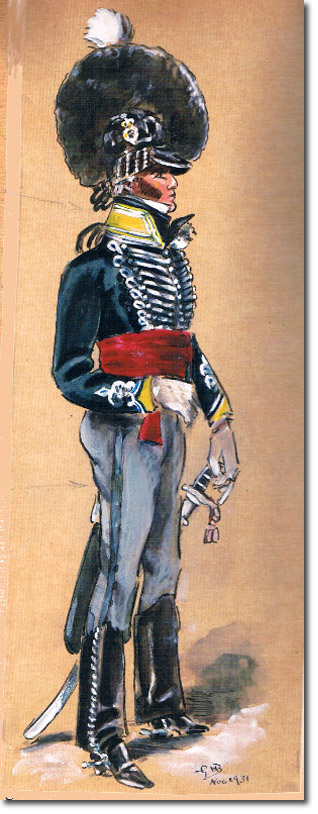|
|


|
|
When the 20th returned to Britain in 1802, and dropped the connection to Jamaica, they adopted the uniform worn by light dragoons in temperate climates. The previous style of blue light dragoon under-jacket and shell had been replaced by the closely braided hussar-style jacket that was waist length. The date of this change was 1796 but the regiments serving in far-flung places like the West Indies would have changed much later, and, in the case of the 20th LD probably not until they arrived back in England. This officer has silver braid and lace but the rank and file had white braid. The tin helmet worn in tropical climates was replaced by the leather Tarleton helmet. The turban worn around the base of the helmet was black for all regiments from 1800 onwards, and a white over red plume attached to the left side. On the right side the regimental badge was worn, and a black bearskin crest covered the top front and back.
This painting by Godfrey Brennen is copied from Robert Dighton's painting of cavalry officers of 1808, in the Royal Collection (see photo). But the officer of the 20th in Dighton's painting wears a grey jacket, not blue. The grey jackets were authorised in 1796 by the Adjutant-General, first in Jan 1796, but there are confusing orders about which parts of the world should have grey and which blue. After some dithering in the January orders the A-G stated categorically in February 1796 that all light dragoons, wherever they are, should wear blue. Then in July 1796 he maintains that the King had countermanded the order so that regiments in India and the Cape should wear grey, and regiments serving in Great Britain, Ireland and West Indies should wear blue. It was well known that the 8th and 19th Light Dragoons wore grey jackets because of their service in India in the early 19th century. The 23rd also had grey uniforms. The 20th, however, were dispersed between Sicily, Britain and Portugal. The previous year 1807 had seen them in South America and Egypt. There seemed to be no regulations for uniform in most of these countries. But Dighton must have observed the 20th wearing the grey uniform so perhaps one of the postings required grey jackets. The painting by Simkin of the 20th at Vimiera in Portugal shows them wearing blue jackets. His painting depicts the smart white breeches and knee boots but the men would more likely to have worn the grey overalls seen in Brennan's/Dighton's painting. They are leather-bottomed to protect them against dust and mud. |
Armed Forces | Art and Culture | Articles | Biographies | Colonies | Discussion | Glossary | Home | Library | Links | Map Room | Sources and Media | Science and Technology | Search | Student Zone | Timelines | TV & Film | Wargames